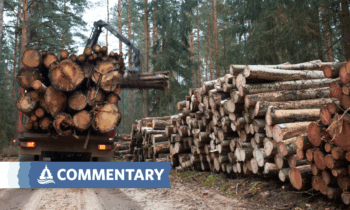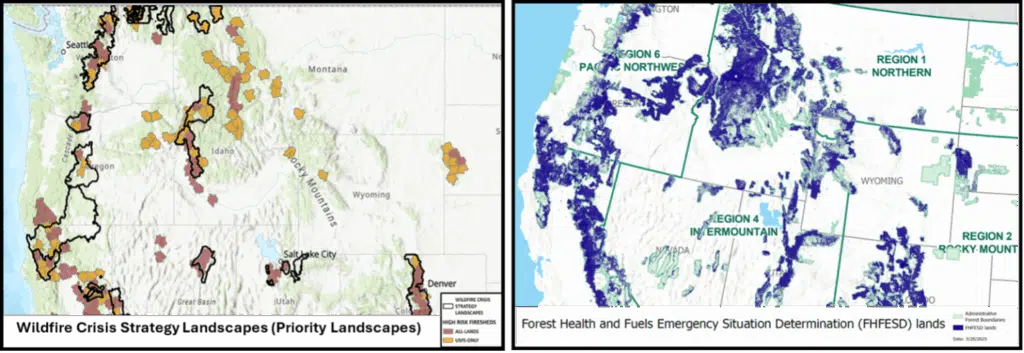Impacts of New Plan to Minimize Environmental Processes & Remove Obstacles to Timber Production

I’ve spent considerable time in national forests—hiking, camping, riding horses, fishing, and cutting firewood. I feel fortunate to have worked for the US Forest Service (USFS) for over 20 years, fulfilling a childhood dream and working for an agency whose multiple-use mission prioritizes resource conservation. This commentary reflects my personal views, written on personal time.
I have big concerns about the recent direction for implementing Executive Order 14225 “Immediate Expansion of American Timber Production,” March 1, 2025, because of the potential for an unchecked focus on timber production. This direction appears to be misaligned with the Forest Service’s mission, has a high potential for resource impacts, and could erode the professional integrity of agency resource specialists.
To be clear, I am not concerned about the goal of increasing timber production by 25% under EO 14225. The Forest Service is a multiple-use agency and timber production is a foundational part of national forest management, as spelled out in the 1897 Organic Act and the Multiple-Use Sustained-Yield Act (MUSYA), as well as in the National Forest Management Act (NFMA). A 25% increase can probably be accomplished in a multiple-use setting with careful planning. My concerns lie with the where and the how of the harvest.
The Forest Service is being directed to pursue timber production outside the sideboards of multiple-use management―contrary to MUSYA and NFMA. This is laid out in Secretary’s Memorandum 1078-006 (April 3, 2025), memos by Acting Chiefs (April 3, 2025, and April 22, 2025), and the National Active Forest Management Strategy (May 29, 2025; NAFM strategy).
The two biggest threats to multiple-use management in these documents are (1) direction to “remove obstacles to timber harvest” and (2) direction to minimize environmental processes, with the documents appearing to recommend timber harvest under the guise of reducing wildfire risk to take advantage of emergency authorities. Carrying out this direction has high potential to work against interests of the American people.
Meeting the needs of the American people is a fundamental part of multiple-use management under the MUSYA, and surveys consistently show that a large proportion of the American public places a higher value on recreation, wildlife, and water/watersheds in national forests than on timber harvests and grazing.
Removing Obstacles
Treatment of conservation measures and design features in the EO, subsequent memos, and the NAFM strategy, reveal a lack of understanding of multiple-use management and the history leading to the enactment of the MUSYA and NFMA.
The NAFM strategy calls for the agency to “Change or eliminate restrictive policies and regulations” (under the heading “Remove Barriers”) and to “Simplify mitigation measures to provide for the longest possible operating periods for partners.” Multiple-use management will be diminished to the degree that necessary and appropriate restrictions are eliminated in order to fully utilize timber resources without consideration of other multiple uses like recreation, watersheds, and habitat for wildlife and fish.
Yes, some conservation measures may be overly burdensome. But scrapping them wholesale is throwing the baby out with the bathwater.
Whereas a portion of three MUSYA purposes (timber harvest, recreation, and livestock grazing) are typically pursued through pre-defined objectives, which are permissive, the other three MUSYA purposes (watersheds, wildlife, and fish) are primarily managed by implementing Forest Plan standards, conservation measures, and design features, which by definition restrict human uses (like roads, timber harvest, and recreation) and management activities (like fuels reduction) that can impact watersheds, wildlife, and fish.
In fact, multiple-use management under NFMA requires management―through design features or mitigation―of uses like timber harvest in ways that allow watersheds, wildlife, and fish to be sustained over the long term. The history behind enacting MUSYA and NFMA reinforces the fundamental importance of harvesting timber within the sideboards of multiple-use management; the framework in the NFMA contributes both to timber production and allows other MUSYA purposes (like recreation, wildlife, and watersheds) to persist in the interest of the American people. Conservation measures and design features are necessary to meet the needs of the American people, given their high interest in wildlife, watersheds, and fish.
Minimizing Environmental Processes
The NAFM strategy also seeks to shortcut NEPA reviews. A key part of the NEPA process is its check on whether proposed projects include sufficient resource protections. So, not only does the new NAFM Strategy direct the USFS to minimize or ignore conservation measures and design features in proposed timber and fuels-management projects, but it will also curtail checks on project design. Should it take less time to complete the NEPA process? Yes, that certainly is a laudable goal. One way to do this is to build needed and appropriate conservation measures and design features into proposed timber sales, as this would reduce the size of the effects analyses.
An important note is that timber sales are still required to be designed and implemented in ways that meet resource standards and guidelines of forest plans prepared through public processes under NFMA, and that documentation is still needed to assess whether they are met for each project. The second-to-the-last sentence of the EO states that “This order shall be implemented consistent with applicable law…,” which of course includes NFMA and by extension, forest plan standards and guidelines. Resource specialists play a critical role here.
Some Implications
To take advantage of the emergency provisions outlined in the Secretary’s memo, which would allow streamlining of NEPA and Endangered Species Act processes, timber sales would need to take place in areas designated as posing an emergency situation for wildfire risk. And the USDA appears to have created a map designating nearly two-thirds of National Forest System (NFS) lands as qualifying for expedited NEPA processes.
The new Emergency Determination Situation includes a map showing 112.6 million acres as an Infrastructure Investment and Jobs Act emergency situation. That is 59% of all NFS lands (Fig. 1.b). This dwarfs the 48 million acres (25% of NFS lands, 48 million acres) designated two years ago under the Wildfire Crisis Strategy (Fig. 1.a).

Figure 1. Maps depicting (a) Wildfire Strategy Landscapes (2023), and (b) Forest Health and Fuels Emergency Situation Determination (2025).
There could very well be areas suitable for timber harvest where the two maps overlap. However, the timber production goal of meeting the demand for “lumber, paper, bioenergy, and other wood products” and the fuels-reduction goal to “save American lives and communities” are entirely different goals.
Beyond raising the risk of legal violations, this new strategy puts resource specialists in an impossible bind: provide input that reflects and upholds the conservation portion of the agency’s mission, even when this may conflict with NAFM directives, or be complicit in failing to do so. That’s not just a policy issue. It has deep and troubling implications to professional integrity and morale.
Editor’s note: The Forest Service removed the Wildfire Crisis Strategy maps from its website in late June or early July.
This commentary was authored by an anonymous Forest Service employee.